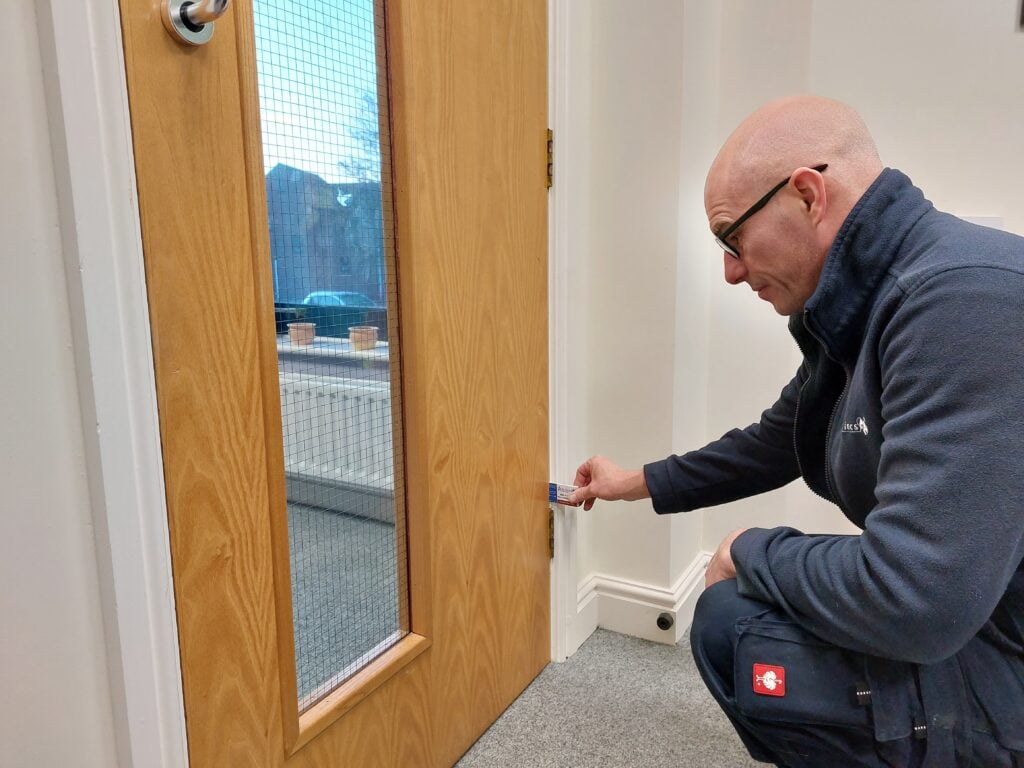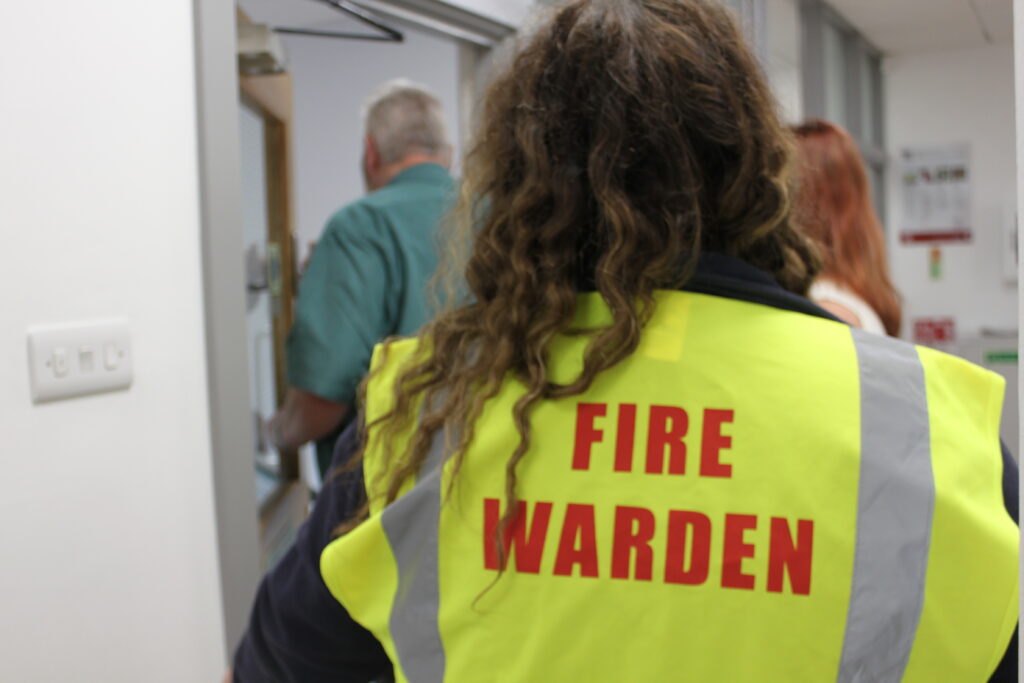Tuesday 16th September 2025

Fire proof doors and internal fire doors are critical components of any building’s passive fire protection system, serving as barriers that prevent the spread of fire and smoke throughout a building. These specialised doors can mean the difference between a minor incident and a catastrophic event, protecting lives and property by maintaining vital escape routes during emergencies. Regular maintenance and inspection of your fire doors ensures they will perform as intended when needed most.
Understanding Fire Door Maintenance Requirements
The importance of maintaining fire proof doors cannot be overstated. Under the Regulatory Reform (Fire Safety) Order 2005, the Responsible Person for any non-domestic premises has a legal duty to ensure all fire safety equipment, including internal fire doors, is maintained in ‘good working order’. This isn’t just a recommendation – it’s a legal requirement that, if ignored, could result in substantial fines or even prosecution.
For residential buildings, the Fire Safety (England) Regulations 2022 introduced additional requirements. Buildings with two or more dwellings must conduct regular fire door inspections, with the frequency depending on the building’s height. In buildings over 11 metres tall, fire doors in communal areas require checking every three months, while flat entrance doors need annual ‘best endeavour’ checks.
The consequences of poor maintenance can be severe. A damaged or poorly maintained fire door may fail to contain fire and smoke, potentially leading to rapid fire spread, blocked escape routes and tragic loss of life. Beyond the human cost, failing to maintain fire doors properly could result in criminal prosecution, unlimited fines and devastating reputational damage.
Essential Components to Inspect
When maintaining fire proof doors, understanding what to inspect is crucial. Every component plays a vital role in the door’s ability to resist fire and smoke. Let’s examine each element in detail.
Door Leaf and Frame
The door leaf itself should be checked for any signs of damage, warping or holes. Even small damage can compromise the door’s integrity. The frame must be securely fixed to the wall with no visible movement when pressure is applied. Check that the door sits properly within its frame – it shouldn’t be twisted or distorted.
Intumescent Seals and Smoke Brushes
Intumescent strips for fire doors are perhaps the most critical component for fire resistance. These strips, embedded around the door edges or frame, expand when exposed to heat, sealing the gaps between door and frame. Inspect these carefully for any damage, paint overspray or missing sections. If your doors are rated FD30s or FD60s (the ‘s’ indicating smoke protection), they’ll also have smoke brushes that prevent cold smoke from passing through – these should be intact and not excessively worn.
Fire Door Closers and Hinges
A fire door is only effective when closed, making the selection of appropriate door closers essential. The door closer should be powerful enough to close the door fully from any angle, overcoming the resistance of seals and latches. Check that it closes at a controlled speed – not slamming but not too slowly either. Fire doors typically require three fire-rated hinges, which should be checked for wear, damage or missing screws.
Gaps and Clearances
Correct gap sizes are crucial for fire door performance. The gap between the door and frame should be consistently 3mm (±1mm) at the top and sides. The threshold gap (bottom of door) should not exceed 10mm, though some manufacturers specify tighter tolerances. Use a gap gauge to check these measurements accurately – excessive gaps will allow smoke and flames to pass through, while gaps that are too small may prevent the door from closing properly.
Comprehensive Inspection Checklist
To ensure thorough maintenance of your internal fire doors, follow this systematic inspection process:
Visual Inspection (Monthly)
- Check for obvious damage to door leaf, frame or glazing
- Ensure fire door signage is present and legible on both sides
- Verify no unauthorised modifications have been made
- Confirm door isn’t wedged open.

Functional Testing (Quarterly)
- Open door to 5 degrees – it should close fully on its own
- Open door to 90 degrees – check it closes firmly into the latch
- Test door from various opening angles
- Verify door closer operates smoothly without jerking
Detailed Component Check (Six-Monthly)
- Measure gaps around all door edges with an appropriate gauge
- Inspect intumescent seals for damage or degradation
- Check all hinges are secure with no missing screws
- Test operation of any fire door retainers or hold-open devices
- Examine glazing and glazing beads if present
- Verify certification labels are still visible
Professional Inspection (Annually)
Consider arranging a professional fire door inspection service by a qualified inspector who can provide detailed reports and identify issues that might be missed during routine checks.
The frequency and type of fire door inspection will vary depending on the type of premises, the risk that exists and the traffic levels in that area of the building.
Common Maintenance Issues and Solutions
Understanding common problems helps you identify and address issues before they become critical failures.
Damaged Intumescent Seals
If intumescent strips show signs of damage, missing sections, or have been painted over, they must be replaced immediately. Retrofitting or replacing fire door seals should be done following manufacturer specifications. Never attempt to repair damaged seals – always replace them entirely.
Door Not Closing Properly
When fire proof doors fail to close fully, the cause often lies with the door closer. Check the closer’s power setting – it may need adjustment for heavier doors or to overcome seal resistance. Remember that EN Power Size 3 is the minimum for fire doors. If adjustment doesn’t resolve the issue, the closer may need replacement.
Excessive Gaps
If gaps exceed specifications, don’t attempt to fix this with additional seals or draught excluders. The door may need rehinging or replacement. For threshold gaps, consider installing a threshold seal or plate, but ensure this doesn’t impede the door’s closing action.
Lock and Latch Problems
Locks and latches must engage properly without excessive force. If the latch doesn’t engage, the door won’t contain fire effectively. Misalignment often causes these issues – adjustment of the strike plate or hinges may resolve the problem. Any replacement hardware must be fire-rated and compatible with your door’s certification.
Best Practices for Fire Door Care
Maintaining internal fire doors requires ongoing attention and proper procedures. Here are essential practices to ensure your doors remain effective:
Regular Cleaning and Care
Keep fire doors clean using mild, non-abrasive cleaners. Avoid harsh chemicals that might damage seals or finishes. Pay particular attention to keeping hinges free from dust and debris, which can affect smooth operation. When cleaning, take the opportunity to perform a quick visual inspection.
Proper Usage Training
Educate all building users about fire door importance. Staff should understand that fire doors must never be wedged open (unless proper fire door hold-open devices are installed), and any damage should be reported immediately. Consider installing clear signage to reinforce these messages.

Documentation and Record Keeping
Maintain detailed records of all inspections, repairs, and replacements. Document:
- Inspection dates and findings
- Any defects identified and actions taken
- Repairs completed with dates
- Component replacements
- Professional inspection reports
- Relevant certification documents
These records demonstrate compliance with legal requirements and help identify recurring issues or doors requiring more frequent attention.
Working with Professionals
While routine checks can be performed in-house by competent persons, some situations require professional expertise:
- Initial installation of new fire doors
- Major repairs or modifications
- Annual detailed inspections
- Investigation of recurring problems
Special Considerations for Different Settings
Different buildings have unique requirements for fire proof doors maintenance:
Residential Buildings
In residential settings, particularly flats and HMOs, flat entrance doors opening onto communal areas require specific attention to fire door regulations. Responsible Persons must make ‘best endeavours’ to inspect flat entrance doors annually, requiring cooperation from residents. Provide educational materials to help residents understand their role in fire door maintenance.
Healthcare Facilities
Care homes and hospitals often use fire door retainers to aid mobility for residents with wheelchairs or walking aids. These devices must be tested regularly to ensure they release when the fire alarm activates. The critical nature of phased evacuation in these settings makes proper fire door maintenance absolutely vital.
Educational Institutions
Schools and universities see heavy daily use of fire doors, accelerating wear. Consider more frequent inspections in high-traffic areas. Ensure doors in areas like science labs or workshops, where fire risk is higher, receive priority attention.
Creating Your Maintenance Schedule
Developing a structured maintenance schedule ensures nothing is overlooked:
Immediate Actions
- Remove any wedges or unauthorised hold-open devices
- Report and address any obvious damage
- Ensure all fire door signage is present
Monthly Tasks
- Visual inspection of all fire doors
- Check for new damage or modifications
- Verify doors aren’t being propped open
Quarterly Requirements
- Functional testing of door closers
- Check the operation of any authorised hold-open devices
- Review high-traffic doors for accelerated wear
Six-Monthly Inspections
- Detailed component inspection
- Gap measurement checks
- Hardware operation verification
Annual Professional Review
- Comprehensive inspection by qualified personnel
- Review and update of maintenance procedures
- Training refresh for staff
Understanding Fire Door Ratings and Standards
When maintaining fire proof doors, understanding their ratings helps ensure appropriate care:
FD30 vs FD60 Ratings
FD30 doors provide 30 minutes of fire resistance, while FD60 doors offer 60 minutes. The rating affects maintenance requirements – FD60 doors typically have more robust construction and may have different seal specifications. Always maintain doors according to their specific rating requirements.
Smoke Control Designations
Doors marked FD30s or FD60s include smoke control features. These doors have additional smoke seals requiring inspection. The ‘s’ designation is particularly important for doors protecting escape routes, where smoke control is critical.
Proper maintenance of fire proof doors and internal fire doors is not just a legal obligation – it’s a critical safety responsibility that protects lives and property. By implementing regular inspection routines, addressing issues promptly and maintaining detailed records, you ensure your fire doors will perform when needed most.
Remember that fire door maintenance is an ongoing process, not a one-time task. Stay informed about changing regulations, invest in proper training, and don’t hesitate to seek professional assistance when needed. The time and resources invested in maintaining your fire doors properly are minimal compared to the potential consequences of neglect.
For comprehensive fire door solutions, from complete door sets to individual components and professional inspection services, ensure you work with reputable suppliers who understand the critical nature of fire door performance. Your commitment to proper fire door maintenance contributes to a safer environment for everyone who uses your building.
All information correct at time of posting.

